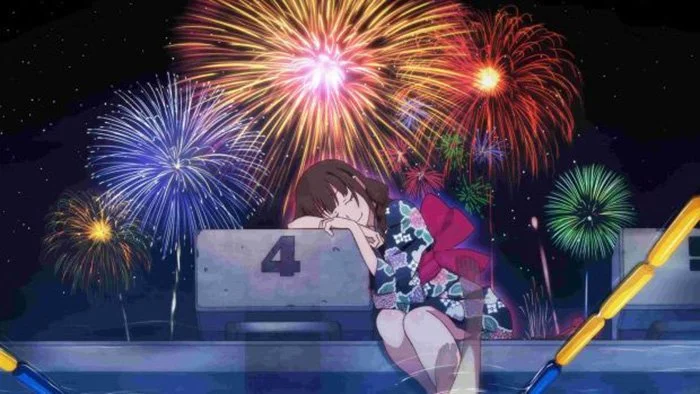
Love, Fireworks and Coming of Age are examined in Fireworks
by Kathia Woods
The school year has come to an end, and a local festival has a fireworks display. There is a discussion amongst a group of sixth graders: Are fireworks round or flat? Does it change whether we look at them from the bottom or the side? Naturally, as most discussions do amongst school-age kids, things get a little heated, and a wager is made. Meanwhile, two of the kids, Norimichi and Yosuke, see their mutual object of obsession, Nazuna, at the swimming pool. A race takes place with the winner having to confess to Nazuna their feelings. Yosuke, the winner, is not exactly forthcoming with his affection. Having lost the race by hitting his leg on the turnaround, Norwich is taken back when Nazuna suggests that he accompany Nazuna to the festival. He insists that she likes him.
It is later revealed that Nazuna was going to ask the winner out to escape her mother and her fiancé. They are planning to move away.
A series of tragic events occur, and Norimichi ends up taking a trip with Nazuna. Meanwhile, the rest of the gang attempt to climb a tower to see the fireworks from the side.
Shunji Iwai directs a compassionate coming-of-age film that focuses primarily on two topics, excluding the entire fireworks dilemma, which primarily serves as an "excuse" for the rest of the narrative and the main source of humor in the film. The relationship between Norimichi and Nozuna, which went through multiple episodes in the movie, is about the other character's determination, reaching the point of manipulating the guys to help her.
She appears to know they like her to achieve her goal, and the former's first love notions cause him to go to extremes to make her want him.
The second is the friendship between boys, which progresses through several stages, most of which involve competition, with the race for Nozuna's love and the betting on the fireworks highlighting the concept most eloquently. Simultaneously, Iwai makes full use of the rural environment to incorporate a road movie element into the tale, which also features coming-of-age components.
The most endearing scene in the film is when the boys shout who they are in love within the middle of nowhere, with their choices, including their schoolteacher, being rather amusing.
Ichiro Chazono's cinematography is quite good, with the way he has captured the rural setting, the school, and the various locations the two groups visit adding to the overall "summer vacation" approach, with the fireworks at the end being the apogee. Koji Kanaya's editing maintains a suitable, relatively fast pace. At the same time, he also appears to strengthen the child actors' performances, with dialogues cutting to the other person each time someone else speaks. In general, the performances are not particularly exciting. Still, Megumi Okita shines as Nazuna. She is the only one who has remained in the entertainment industry, recording albums, and appearing in films such as "Ju-on: The Grudge."
Fireworks, Should We See It From The Bottom or The Side is an exceptionally easy-to-watch film that also serves as a fantastic introduction to Shunji Iwai's work.

